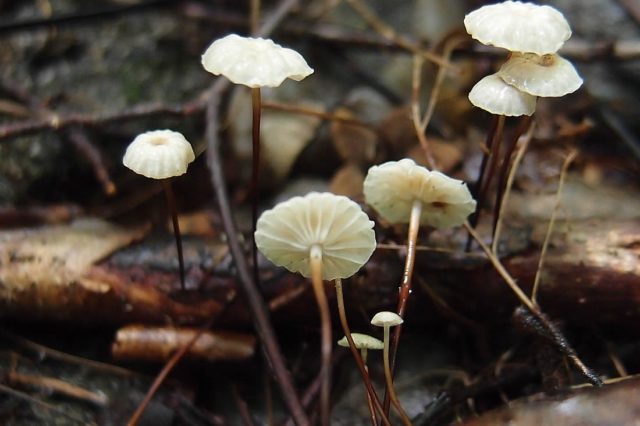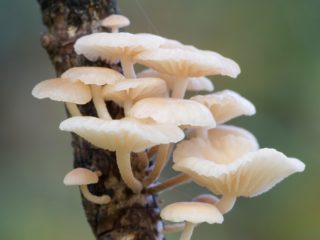Content
Marasmius rotula is a miniature fruiting body from the Negniuchnikov family and the Negniuchnik genus. It was first described and classified by the Italian-Austrian naturalist Giovanni Scopoli in 1772 as a wheel-shaped champignon. Its other names:
- Merulius collarata, from 1796, W. Withering;
- micromphale collar, from 1821, S. Gray;
- stamen wheel-shaped, since 1887, N. Patouillard;
- Chameceras coliform, since 1898, O. Kunze.
What does the wheel-shaped rotten rotting grass look like?
The fruiting bodies, even at maturity, are small in size. The legs are thin and, in comparison with the caps, significantly elongated, thread-like in shape.

The circumference of the cap rarely exceeds the size of an ordinary snail
Description of the cap
The caps of newly emerged mushrooms have the appearance of a rounded ribbed screw head. The middle is straight or with a small funnel-shaped depression, with a dark reddish-brown tubercle. From half the diameter, the surface is lowered down almost at a right angle, in some cases the edges are slightly tucked towards the stem. As it develops, the cape straightens its cap, which first becomes dome-shaped, then umbrella-shaped, and then spread out, often with the edges lowered down. A narrow funnel in the place of growth to the stem is preserved and deepens. The diameter varies from 0.3 to 1.4 cm.
The surface is mucous-moist, smooth. Longitudinal wavy or smooth, tuberculate in overgrowths. Snow-white or creamy-yellowish in color, with a dark center. Sometimes with brown spots, when dry it becomes sandy-brown or light ocher. The margin is sinuous-toothed, segmented, often wavy. The pulp is thin, fragile, with an unpleasant odor.
The hymenophore's plates are sparse, sometimes tortuous; the inside of the cap is very reminiscent of flower petals or an umbrella attached to a collar-collarium. The color is similar to the color of the cap. Spore powder is white.

The radial plates of the hymenophore are clearly visible through the parchment-thin pulp.
Description of the leg
The wheel-shaped rotten grass has a long leg. Thin, no more than 1.8 mm, smooth, hollow inside. Often curved, from 2 to 9 cm long.The color is uneven; young mushrooms have a lighter color. Dark at the root: from resinous amber, brown, golden to chocolate and coal black, and silvery white or cream at the cap. When dry, the leg becomes wrinkled and longitudinally folded.

Dried legs take on the appearance of a charred match
Where and how does it grow
The rotting grass grows on rotting wood, thick forest litter, dead wood and on old, rotten stumps. Loves damp places. Prefers deciduous or mixed forests. Found frequently and everywhere, it is a cosmopolitan mushroom. Distribution area: Europe, Asia, North America. In Russia, it is most common in Siberia and the northern Caucasus.
It grows in large colonies, forming amazingly beautiful white-star-shaped inclusions against the background of brown forest litter. The fruiting period of the mycelium is from July to October.

Favorite habitat: fallen, wet tree trunks
Is the mushroom edible or not?
The rotten mushroom is classified as an inedible mushroom due to its unpleasant odor and low nutritional value. There is no data on its toxicity.
Doubles and their differences
The wheeled rotten grass can be confused with other representatives of its species.
Cheese honey fungus (Marasmius bulliardii). Inedible due to its miniature size.The color and shape of the cap are completely the same, snow-white at first, but with age it changes its color to ocher, cream or pinkish. The only noticeable difference is that the plates of the hymenophore are not attached to the collar on a stalk, like those of the hymenophore.

Amazingly beautiful mushrooms that are hard to notice
Conclusion
Negnyuchnik wheel-shaped is an exquisitely fragile miniature mushroom from the genus Negnyuchnik. It lives on deciduous and coniferous waste, pieces of half-rotted bark, rotting stumps and tree trunks. Loves places saturated with moisture, gullies, lowlands. It is found in deciduous and mixed forests throughout the Northern Hemisphere. In Russia, it can be seen especially often in the Caucasus and taiga forests. Inedible, the pulp has a strong unpleasant odor. There is no data on its toxicity. Used in laboratories as a determinant of certain substances. Has inedible counterparts belonging to its species.








